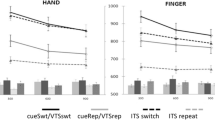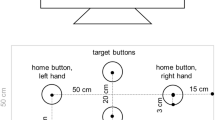Abstract
The hypothesis that focal hand dystonia (FHD) is associated with impaired inhibitory function is supported by a broad base of evidence from studies of neurophysiological function. The purpose of this study was to investigate the inhibition of a pre-planned response in FHD and control subjects. Nine FHD subjects and 11 control subjects performed an anticipated response task, which required them to lift their index finger from a keyboard button to stop the sweep of an indicator at a specified point on a sweep-dial. The affected hands of the FHD subjects were tested, as were the dominant hands of the control subjects. Electromyographic (EMG) data were recorded from the long finger extensors of the tested arm. On 90 out of 220 trials, the sweep indicator would stop prior to the specified point, and subjects were instructed to continue holding the key down when this occurred. The sweep indicator stopped 10 times at each of nine different points around the dial in a randomised order. The accuracy of subjects’ performance when stopping the sweep indicator at the specified point, and the proportion of ‘stop’ trials where they successfully inhibited this pre-planned response, were recorded. The sweep indicator stop time at which each subject had a 50% probability of successfully inhibiting their response (R 50) was calculated, as was the probability of extensor EMG (burst) activity occurring during a successfully inhibited response. For FHD subjects, it was found that R 50 was significantly lower, and the probability of an extensor EMG burst occurring during a successfully inhibited response was significantly higher, compared to control subjects. These results are discussed with respect to the ‘horse-race’ model for the inhibition of pre-planned responses.





Similar content being viewed by others
References
Brandfonbrener AG (1995) Musicians with focal dystonia: a report of 58 cases seen during a ten-year period at a Performing Arts Medicine Clinic. Med Probl Perform Artists 10:121–127
Ceballos-Baumann AO, Passingham RE, Warner T, Playford ED, Marsden CD (1995) Overactive prefrontal and underactive motor cortical areas in idiopathic dystonia. Ann Neurol 37:363–372
Chen R, Hallett M (1998) Focal dystonia and repetitive motion disorders. Clin Orthop Rel Res 351:102–106
Chen RS, Tsai CH, Lu CS (1995) Reciprocal inhibition in writer’s cramp. Mov Disord 10:556–561
Chen R, Wassermann EM, Canos M, Hallett M (1997) Impaired inhibition in writer’s cramp during voluntary muscle activation. Neurology 49:1054–1059
Cohen LG, Hallett M (1988) Hand cramps: clinical features and electromyographic patterns in a focal dystonia. Neurology 38:1005–1012
De Jong R, Coles MGH, Logan GD, Gratton G (1990) In search of the point of no return: the control of response processes. J Exp Psychol Hum Percept Perform 16:164–182
Fahn S (1989) Assessment of the primary dystonias. In: Munsat TL (ed) Quantification of neurological deficit. Butterworth, Stoneham, MA, pp 241–270
Fahn S, Marsden CD, DeLong MR (eds) (1998) Dystonia 3. Lippincott Raven, Philadelphia
Gilio F, Curra A, Lorenzano C, Modugno N, Manfredi M, Berardelli A (2000) Effects of botulinum toxin type A on intracortical inhibition in patients with dystonia. Ann Neurol 48:20–26
Hummel F, Andres F, Altenmuller E, Dichgans J, Gerloff C (2002) Inhibitory control of acquired motor programmes in the human brain. Brain 125:404–420
Lederman RJ (1991) Focal dystonia in instrumentalists: clinical features. Med Probl Perform Artists 6:132–136
Levy LM, Hallett M (2002) Impaired brain GABA in focal dystonia. Ann Neurol 51:93–101
Lim VK, Altenmuller E, Bradshaw JL (2001) Focal dystonia: current theories. Hum Mov Sci 20:875–914
Logan GD, Cowan WB (1984) On the ability to inhibit thought and action: a theory of an act of control. Psychol Rev 91:295–327
Marsden CD, Sheehy MP (1990) Writer’s cramp. Trends Neurosci 13:148–153
McGarry T, Franks IM (1997) A horse race between independent processes: evidence for a phantom point of no return in the preparation of a speeded motor response. J Exp Psychol Hum Percept Perform 23:1533–1542
Naumann M, Reiners K (1997) Long-latency reflexes of hand muscles in idiopathic focal dystonia and their modification by botulinum toxin. Brain 120:409–416
Newmark J, Hochberg FH (1987) Isolated painless manual incoordination in 57 musicians. J Neurol Neurosurg Psychiatry 50:291–295
Odergren T, Iwasaki N, Borg J, Forssberg H (1996) Impaired sensory-motor integration during grasping in writer’s cramp. Brain 119:569–583
Oga T, Honda M, Toma K, Murase N, Okada T, Hanakawa T, Sawamoto N, Nagamine T, Konishi J, Fukuyama H, Kaji R, Shibasaki H (2002) Abnormal cortical mechanisms of voluntary muscle relaxation in patients with writer’s cramp: an fMRI study. Brain 125:895–903
Oldfield RC (1971) The assessment and analysis of handedness: the Edinburgh inventory. Neuropsychologia 9:97–113
Osman A, Kornblum S, Meyer DE (1986) The point of no return in choice reaction time: controlled and ballistic stages of response preparation. J Exp Psychol Hum Percept Perform 12:243–258
Panizza M, Hallett M, Nilsson J (1989) Reciprocal inhibition in patients with hand cramps. Neurology 39:85–89
Rona S, Berardelli A, Vacca L, Inghilleri M, Manfredi M (1998) Alterations of motor cortical inhibition in patients with dystonia. Mov Disord 13:118–124
Schenk T, Mai N (2001) Is writer’s cramp caused by a deficit of sensorimotor integration? Exp Brain Res 136:321–330
Serrien DJ, Burgunder JM, Wiesendanger M (2000) Disturbed sensorimotor processing during control of precision grip in patients with writer’s cramp. Mov Disord 15:965–972
Sheehy MP, Marsden CD (1982) Writers’ cramp—a focal dystonia. Brain 105:461–480
Sheehy MP, Rothwell JC, Marsden CD (1988) Writer’s cramp. Adv Neurol 50:457–472
Siebner HR, Tormos JM, Ceballos-Baumann AO, Auer C, Catala MD, Conrad B, Pascual-Leone A (1999) Low-frequency repetitive transcranial magnetic stimulation of the motor cortex in writer’s cramp. Neurology 52:529–537
Slater-Hammel AT (1960) Reliability, accuracy, and refractoriness of a transit reaction. Res Q 31:217–228
Tinazzi M, Priori A, Bertolasi L, Frasson E, Mauguiere F, Fiaschi A (2000) Abnormal central integration of a dual somatosensory input in dystonia. Evidence for sensory overflow. Brain 123:42–50
Valls-Solé J, Hallett M (1995) Modulation of electromyographic activity of wrist flexor and extensor muscles in patients with writer’s cramp. Mov Disord 10:741–748
Yazawa S, Ikeda A, Kaji R, Terada K, Nagamine T, Toma K, Kubori T, Kimura J, Shibasaki H (1999) Abnormal cortical processing of voluntary muscle relaxation in patients with focal hand dystonia studied by movement-related potentials. Brain 122:1357–1366
Acknowledgements
The authors thank Dr. T. McGarry for his comments on an earlier draft of this manuscript. CMS is supported by the Foundation for Research, Science and Technology. This project was supported by grants from Mr. P. Baines, the University of Auckland Graduate Research Fund, and the Neurological Foundation of New Zealand.
Author information
Authors and Affiliations
Corresponding author
Rights and permissions
About this article
Cite this article
Stinear, C.M., Byblow, W.D. Impaired inhibition of a pre-planned response in focal hand dystonia. Exp Brain Res 158, 207–212 (2004). https://doi.org/10.1007/s00221-004-1891-4
Received:
Accepted:
Published:
Issue Date:
DOI: https://doi.org/10.1007/s00221-004-1891-4




